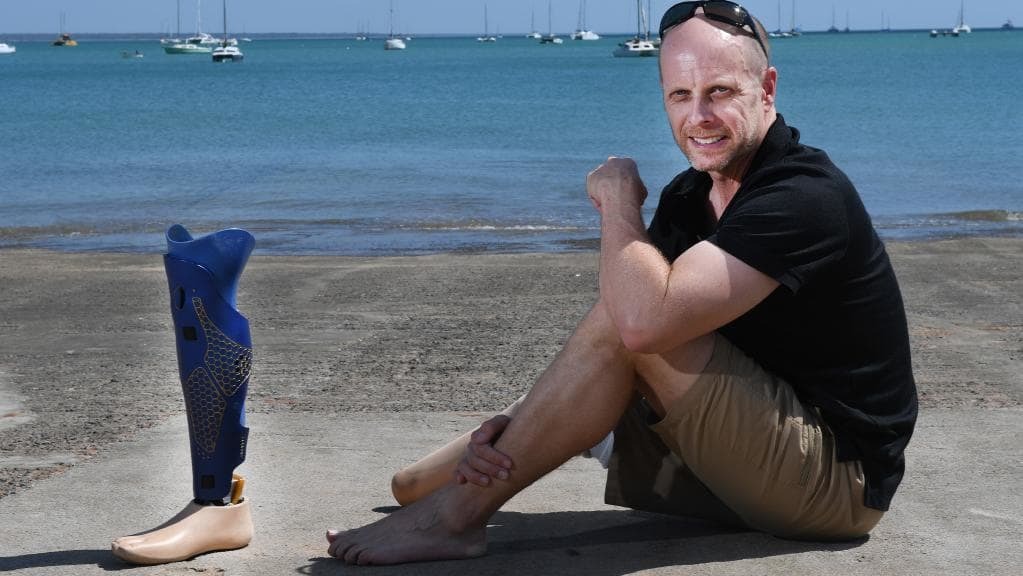



One step at a time responding to people with disability
By Jason Diederich
I am pretty passionate about making lives better for people with disability. It is the clearly the right thing to do, to work with the community to drive accessibility and inclusion for people who face barriers and limitations.
But I confess, it’s not complete altruism that drives me, there is a bit of self-interest too.
Did I mention I have a prosthetic leg?
As most people with disability know, many of the barriers we face in the community are not physical but are more attitudinal. What many people don’t realise is that their subconscious thoughts, feelings and behaviours can have a major impact for people with disability.
There are still a lot of people in the community who have low expectations of how they think a person with disability should interact with the world. When that person does something outside of those expectations, it can make for some interesting responses from people without disability.
There may be clinical terms for these reactions, but here’s my unofficial take – which other people with visible disabilities will relate to – on the reactions I get walking down the street in a pair of shorts.
(Of course, I’m only highlighting my experience to encourage people to think differently,- not to criticise individuals who I’ve no doubt mean well).
Oh, did I mention my prosthetic leg is bright blue?
So, rightly or wrongly, here are my broad categories of response when people see my bright blue prosthetic leg.
1. The puzzled look – The quizzical looks on people’s faces when they see my prosthetic leg is quite amusing. This shows that this person is perplexed as to what is going on. ‘What is that on their leg? Why are they making it so obvious? Why aren’t they covering it up?’ In extreme cases the puzzled look escalates to an angry ‘WTF?’ look instead.
2. The patroniser – This facial expression usually comes with a head tilt and a kind smile, and reflects how this person is feeling all warm and fuzzy because of how brave I am, how courageous I am, for getting out of bed and walking down the street. Which basically means that they never expected me to be able to do that.
3. The over-the-top – This person is worried that I will think they are ignoring me because I have a disability, so they go over the top in the way they interact, although won’t mention my disability at all. They may talk quite loudly and enthusiastically. ‘It’s a LOVELY day isn’t it? How are YOU GOING?’. This person may think that I am probably lonely and sad because I have a disability. So they are doing their bit to cheer me up.
4. The combo – The over-the-top-patroniser – combine type 2 and 3 above. Head tilt, kind smile, loud and enthusiastic greetings.
5. The think-they-are-doing-the-right-thing – These people are genuinely impressed by the fact I have left my house (or perhaps, in their mind, my group home) and want me to know they appreciate how inspiring I have been. It usually manifests by them saying things like ‘so good to see you out and about’ or ‘Good on you, mate’. I am not talking about when I climb a mountain, or complete a marathon, I am talking about when I am walking to the train station, or in Coles buying two-minute noodles. Again, they have low expectations of what I, as a person with disability, might be able to achieve.
6. The obvious-ignorer – This person goes to great lengths to ignore my disability, usually by looking in the completely opposite direction and pretending they haven’t seen me (for example, quickly averting their gaze to something extremely interesting on the powerlines across the street). This person doesn’t want to interact with me at all, as they are nervous they will say or do the wrong thing, and it’s all a bit awkward.
7. The don’t-notice-don’t-care – This person acts like they barely notice me, and carry on as if I am a human being like everyone else …. This is very refreshing, I like this one. In fact, this is where I want the world to get to. When disability out in the community becomes normalised, and people don’t even think twice about it, what a wonderful world that would be.
Just before we move on, there are two more honourable mentions…
8. The don’t-notice-don’t-care wannabe – A subtle variation on the previous, this person is the same, but their eyes nearly come out of their sockets as they try to inconspicuously look down at my prosthetic limb.
9. The healer – This person can initially react in any of the first five ways above, but will follow up by advising me that Jesus can heal me, or that God will cure my condition.
Despite coming up with these categories over time, there’s no hard feelings for anyone.
How we are conditioned over time, and our life experience, all influence how we think, feel, and behave when we are faced with a person who may be different in some way.
The fact is, when any of us are faced with something or someone a little different, we all react in such a way. We think, we feel, we behave in a particular way, and that will have an impact on others.
- If we see someone in a wheelchair, we might subconsciously do the over-the-top thing
- If we see someone with an intellectual disability, we might do the patronising thing
And it’s not just disability:
- If we see two guys holding hands, we might do the puzzled look
- If we see a transgender person, we might look the other way
- If we see a person wearing a hijab, someone with skin colour different to our own, or someone talking a different language, we may think, feel, behave in ways that negatively impact that person without even realising it
And this goes for all of us. Not only do I have a disability, I am also a gay man. But just because someone, myself included, has ‘membership’ to a particular diversity group (or groups), doesn’t automatically make them inclusive.
We need to recognise that the impact we have on others is as big as the impact others may have on us, or possibly even bigger.
So I believe the first step is to acknowledge that inclusion begins at home, and we need to accept that we may be inadvertently treating others in ways we prefer not to be treated ourselves.
It’s confronting to think that we may be thinking, feeling, behaving in set patterns that impact other people negatively.
But if we want others to treat us inclusively, to treat us with respect, to treat us as ‘normal’, then we first need to show that same respect to others.
Next time you see someone a bit different, take note of your reaction, and ask yourself:
- How would I feel if someone reacted that way to me?
- Why did I react that way?
- What does my reaction say about me?
- What can I take from this so that I might react differently next time?
The second step is for those of us who are members of these diversity groups. We need to make sure our differences are not hidden but seen by the community.
Oh, did I mention that my prosthetic leg is bright blue with cybertronic shapes and patterns?
Jason Diederich became an amputee at the age of 10 after being born without muscles below his knee in his right leg. He won silver medals in swimming at the Seoul and Barcelona Paralympics. Jason is now a board member and peer support volunteer with Limbs4Life, a community group that supports amputees. With a background in Occupational Therapy, Jason also works in the disability sector to drive inclusion and support people with disability to connect with their community.
